

The year's special events in the sky
Sun:
Looking
at the Sun either with the unaided eye or through binoculars or a telescope is EXTREMELY
DANGEROUS!
PERMANENT EYE DAMAGE CAN AND PROBABLY WILL OCCUR. Click
here
to find out how to observe the Sun safely.
Moon Phases:
The Moon is ideal for viewing in the week centred on the First Quarter phase, both regarding the sights presented and the most convenient time for observing (evenings). In addition, it is quite high in the sky at sunset. First Quarter in 2024 will occur on the following dates:
2024: January 18; February 17; March 17; April 16; May 15; June 14; July 14; August 13; September 11; October 11; November 09; December 09.
Eclipses in 2024:
Lunar:
PENUMBRAL, MARCH 25: The next lunar eclipse visible from Australia will occur on this night, but it is only penumbral. The eclipse will begin at 2:53 pm, when the Moon is below our horizon. Maximum eclipse will be at 5:12 pm. The Full Moon will rise at 5:55 pm, but the Earth's shadow in penumbral eclipses is very faint. Although about two thirds of the Moon will be immersed in the penumbra, the effect will be hardly noticeable. The eclipse will end at 7:32 pm.
PARTIAL, SEPTEMBER 18: This partial eclipse will occur around midday, when the Moon will be below our horizon. No part of it will be visible from Australia. The next total lunar eclipses visible from the Sunshine Coast will occur on September 8, 2025 (in the hours before dawn), and on March 3, 2026 (perfectly timed to occur between 6:44 pm and 12:23 am).
Solar:
TOTAL
, APRIL 09: No part of this eclipse of the Sun will be visible from anywhere in Australia, as the main eclipse shadow will only pass over the eastern Pacific, Mexico, the eastern half of the USA, Newfoundland and the North Atlantic. Asia, Europe, Africa and South America will miss out this time. The best places to view the eclipse are Mexico, Texas, Arkansas, Kentucky, Ohio, Lake Ontario, Maine, New Brunswick and Newfoundland. The largest city totally in the eclipse track will be Dallas, Texas. This will be the second total eclipse visible from the central United States in just seven years, after the solar eclipse of August 21, 2017. Totality will pass through the town of Wapakoneta, Ohio, the home of the late Neil Armstrong, the first man on the Moon. This will be the last total solar eclipse visible in the contiguous United States until August 23, 2044.ANNULAR, OCTOBER 3 (AEST): This total eclipse of the Sun will not be visible from Australia. It will begin in the northern Pacific Ocean and will head south-east towards Cape Horn in South America. The only places where the eclipse path will cross land are in the far south of Chile and Argentina, and the Falkland Islands.
The next total solar eclipse visible from parts of Australia will occur at 12:56 pm on July 22, 2028, the eclipse track running from Wyndham in Western Australia through Alice Springs to Birdsville and then Sydney, before crossing the Tasman Sea to Dunedin in New Zealand's South Island.
The Planets in 2024:
Mercury:
January 2: Western stationary point
January 13:
Greatest elongation from Sun in morning sky (23
February 3:
Aphelion
February 28: Superior conjunction
March 18: Perihelion
March 25: Greatest
elongation from Sun in evening sky (18
April 2: Eastern stationary point
April 12:
Inferior conjunction
April 25: Western stationary point
May 1:
Aphelion
May 10: Greatest elongation from Sun in
morning sky
(26
June 14: Perihelion
June 15: Superior
conjunction
July 22: Greatest
elongation from Sun in evening sky (26
July 28:
Aphelion
August 5:
Eastern stationary point
August 19: Inferior conjunction
August 29: Western stationary
point
September 5: Greatest
elongation from Sun in morning sky (18
September 10:
Perihelion
October 1: Superior conjunction
October 24: Aphelion
November 16: Greatest elongation from Sun in evening sky (22
November 26:
Eastern stationary point
December 6:
Inferior conjunction
December 7:
Perihelion
December 16:
Western stationary point
December 25:
Greatest elongation from Sun in morning sky (21
January 19, 2025: Aphelion
The best times for observing Mercury in the evening sky are: last
two weeks of January; second week of May to end of month;
most of September. beginning of January 2022.
The best times for observing Mercury in the morning sky are:
mid-February to second
week of March, last week of June to second week in July, third and fourth weeks
of October.
Venus:
March 20:
Aphelion
June 5:
Superior conjunction
July 10: Perihelion
October 30:
Aphelion
January 10, 2025:
Greatest elongation from Sun in evening sky (47
From
January to the end of April, Venus will be close to the Sun and hard to detect.
It will reappear in the western twilight sky during June, and from July on will dominate the western twilight sky as an 'Evening Star'.
In August it will
appear as a little 'gibbous Moon' with a phase of 82% and a diameter of 13 arcseconds. At the end of March it will appear like a small 'half-Moon' with a
phase of 50%, but its diameter will have increased to 24 arcseconds. By the
beginning of May its phase will have reduced to 24% (like a crescent Moon), but
as its angular size will have increased to 39 arcseconds, its brightness will
remain unchanged at magnitude -4.5. Venus will pass through inferior
conjunction (between the Earth and the Sun) on June 4, and will therefore move
from the evening sky to the pre-dawn sky. Whereas on very rare occasions Venus
will pass in front of the Sun at such times (a 'transit of Venus'), on this
occasion Venus will pass 14 arcminutes north of the Sun's limb (edge). In the
morning sky, Venus will appear as a crescent during July, and as a 'half-Moon' in
mid-August. Towards the end of the year it will have shrunk in size and
increased in phase until it appears as a tiny 'Full Moon'. Venus will become
visible in the western evening sky in May 2021.
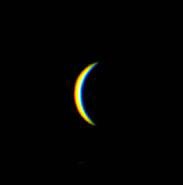
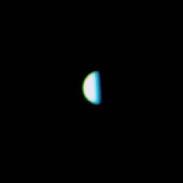
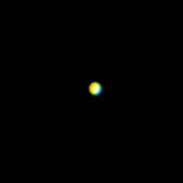
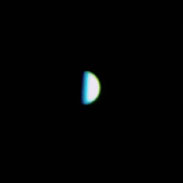
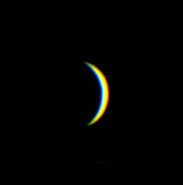
early July 2020 mid-August 2020 March 2021 October 2021 December 2021
Mars:
May 8: Perihelion (angular diameter = 4.8")In January 2024, Mars will be on the far side of its orbit, and therefore will appear quite small, less than 4 arcseconds in diameter. It will slowly increase in size and brightness as the Earth catches it up during the year.
Jupiter:
Saturn:
May
19: Conjunction
September 12: Western quadrature
October 9:
Western stationary point
December 8:
Opposition (Jupiter rises in the east at sunset)
The
giant planet begins 2024 in the constellation of Aries, the Ram, but
crosses into Taurus. the Bull, on April 28.
June 9: Western quadrature
June 30: Western stationary point
September 8: Opposition
November 15: Eastern stationary point
December
5:
Eastern quadrature
March 12, 2025: Conjunction
Saturn
will spend all of 2024 in the constellation of Aquarius.
Uranus:
January 27: Eastern stationary point
Uranus will begin
2024 in the constellation of Aries, and will cross into Taurus on May 23, 2024.
Neptune:
March 17: Conjunction
Pluto:
January 20: ConjunctionPluto begins 2024 in Sagittarius, but on January 3 it crosses into Capricornus. It will not move out of this constellation until March 15, 2039.
Meteor Showers:
January
4: Quadrantids
February 8: Alpha-Centaurids
April
22: Lyrids
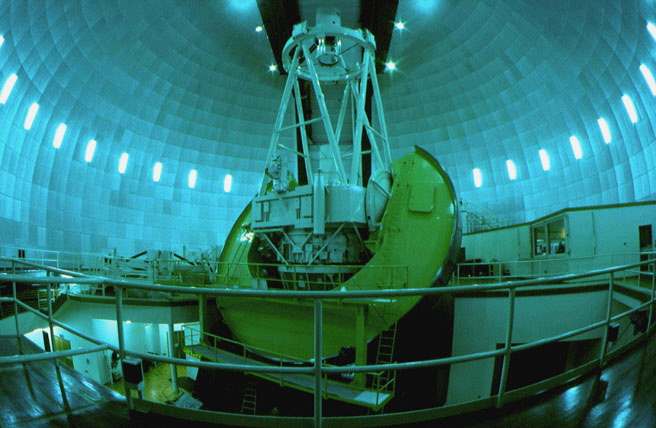
The 3.9 metre Anglo-Australian Telescope near Coonabarabran, NSW
The main Constellations visible at about 8.00 pm each month, from the horizon to the zenith:
January:
East:
Hydra, Canis Minor, Canis Major, Puppis
South: Crux, Musca,
Carina, Vela, Pavo
West: Aquarius, Capricornus, Pisces, Grus,
Piscis Austrinus, Phoenix, Cetus, Eridanus
North: Aries, Perseus, Taurus, Auriga,
Gemini, Orion
February:
East:
Leo, Crater, Corvus, Hydra, Canis Major, Puppis
March:
East:
Virgo, Libra, Lupus, Centaurus, Corvus, Crater, Hydra, Crux, Musca, Vela
South: Triangulum Australe, Toucan,
Carina, Puppis
West: Phoenix, Cetus, Eridanus, Taurus,
Orion, Canis Major
North: Gemini, Cancer, Leo, Canis Minor
April:
East:
Bootes, Libra, Scorpius, Virgo, Centaurus, Lupus, Ara, Crux, Musca, Corvus
South: Triangulum Australe, Pavo, Carina,
Vela
West: Eridanus, Orion, Gemini, Canis
Minor, Canis Major, Puppis
North: Cancer, Ursa Major, Leo, Crater, Hydra
May:
East:
Corona Borealis, Serpens, Ophiuchus, Sagittarius, Libra, Scorpius, Ara,
Lupus, Centaurus
South: Indus, Pavo, Triangulum Australe, Crux,
Musca, Carina
West: Canis Major, Canis Minor, Cancer,
Puppis, Hydra
North: Ursa Major, Leo, Coma Berenices,Bootes,
Virgo, Crater, Corvus
June:
East:
Ophiuchus, Capricornus, Sagittarius, Scorpius
South: Pavo, Triangulum Australe, Ara,
Lupus, Crux, Musca
West: Hydra, Leo, Carina, Vela, Puppis,
Crater, Corvus
North: Coma Berenices, Bootes, Corona Borealis,
Hercules, Virgo, Serpens, Libra
July:
East:
Aquarius, Delphinus, Grus, Capricornus, Aquila, Sagittarius, Scorpius
South: Carina, Musca, Crux, Ara, Triangulum Australe,
Centaurus
West: Hydra, Crater, Corvus, Virgo, Vela,
Libra
North: Bootes, Corona Borealis, Hercules,
Lyra, Ophiuchus, Serpens
August:
East:
Aquarius, Phoenix, Piscis Austrinus, Grus, Sagittarius
South: Eridanus, Musca, Crux, Triangulum
Australe
West: Corvus, Virgo, Bootes, Libra,
Centaurus, Ara, Lupus, Scorpius
North: Corona Borealis, Hercules, Lyra, Cygnus,
Delphinus, Aquila
September:
East:
Pisces, Cetus, Eridanus, Phoenix, Piscis Austrinus, Grus, Aquarius,
Capricornus
South: Crux, Musca, Triangulum Australe, Pavo
West: Centaurus, Libra, Serpens,
Ophiuchus, Scorpius, Lupus, Ara
North: Lyra, Cygnus, Pegasus, Delphinus,
Aquila
October:
East:
Eridanus, Cetus, Aries, Piscis Austrinus
South: Hydrus, Centaurus, Musca,
Triangulum Australe, Ara, Pavo, Grus
West: Lupus, Scorpius, Ophiuchus,
Sagittarius, Aquila, Capricornus
North: Cygnus, Delphinus, Pegasus,
Andromeda, Aquarius
November:
East:
Taurus, Eridanus, Cetus, Phoenix
South: Carina, Musca, Triangulum Australe, Pavo
West: Scorpius, Sagittarius,
Aquila, Delphinus, Capricornus, Grus, Piscis Austrinus
North: Pegasus, Andromeda, Aries, Pisces,
Cetus, Aquarius
December:
East:
Taurus, Orion, Canis Major, Puppis, Carina, Eridanus
South: Carina, Musca, Pavo
West: Capricornus, Aquarius,
Grus, Piscis Austrinus, Phoenix
North: Pegasus, Andromeda, Aries, Perseus,
Cetus
Observatory Home Page and Index